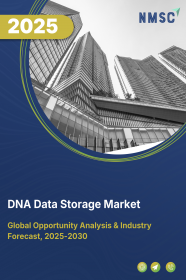
DNA Data Storage Market by Product Type (Commercial, and Research & Prototyping), by Deployment (Cloud, and On-Premise), by Application (Archival, Quality Control, and Research & Prototyping), by Sequencing Platform (Next-Generation Sequencing, and Nanopore Sequencing), by Synthesis Platform (Chemical-Column Based, Chemical-Microchip Based, and Enzymatic), and by End User - Global Opportunity Analysis and Industry Forecast 2025-2030
US Tariff Impact on DNA Data Storage Market
Trump Tariffs Are Reshaping Global Business
DNA Data Storage Market Overview
The global DNA Data Storage Market size was valued at USD 93.19 million in 2024 and is predicted to reach USD 2980.62 million by 2030 with a CAGR of 78.5% from 2025-2030. DNA data storage market refers to the commercial sector focused on the development, production, and deployment of technologies and solutions that utilize DNA molecules as a medium for storing large amount of data. This market includes companies providing innovative methods to encode, store and retrieve digital information in DNA sequences, offering unprecedented data density and long-term stability compared to traditional storage.
DNA data storage solutions are targeted towards businesses and organizations that require advanced data storage solutions, such as tech companies, research institutions, and data centres, enabling them to manage large volume of data efficiently.
Market Dynamics and Trends
The rising digital transformation across various industries including BFSI, healthcare, government for innovative data storage solution is significantly driving the market growth. DNA data storage solutions offer efficient data storage solution to handle large scale digital projects and data heavy applications. As per a survey conducted by Gartner, in North America and Europe around 39% enterprises adopted industry cloud solutions and it is estimated more 17% enterprises to adopt industry cloud solutions by the end of 2026.
This surge in the adoption of digital technologies for operation, customer engagement, and analytics generate large amount of data. DNA data storage facilitates robust solutions with its high capacity and long-term durability, making it ideal for businesses looking to efficiently manage and preserve vast digital information.
Moreover, the exponential increase in data generation across industries including healthcare, finance and technology creating a need for advanced storage solutions, that in turn fueling the market. According to a report published by the National Institute of Health, around 30% of the global data volume is generated by the healthcare industry. Also, the data generated by the healthcare sector is expected to grow at a CAGR of 36% by 2025. DNA data storage provide cutting-edge data storage solution capable of storing vast amount of information in a very limited physical space and preserve it for a long time. This high-density, long term storage capability makes DNA storage an idle solution for businesses, that requires to manage and store large volume of data.
Furthermore, the growing number of technological advancements in DNA synthesis, sequencing, and data encoding are further propelling the growth of the market. Innovations such as biotechnology and nanotechnology enable more efficient and accurate ways to write, read and store data in DNA. For instance, in December 2023, Biomemory, a Paris-based startup, launched the first commercially available DNA storage solution that comes in a credit card size format. This new storage device leverages high density data storage capabilities of DNA, potentially revolutionizing data preservation. Through these launches DNA data storage technologies continue to evolve, reducing cost along with enhancing the feasibility of using DNA as a high density, long-term, and large volume data storage solutions for businesses.
However, the high cost associated with synthesizing and sequencing of DNA data storage is restraining the growth of the market.
On the other hand, the introduction of nanostructured DNA arrays and DNA flash memory are expected to create ample growth opportunities for the market in the future. These cutting-edge technologies allows more effective and scalable way to store data using DNA, making it suitable to store even larger volumes of information in smaller physical spaces.
Market Segmentation and Scope of Study
The global DNA data storage market report is segmented on the basis of product type, deployment, application, sequencing platform, synthesis platform, end-user, and geography. Based on product type, the market is classified into commercial, and research & prototyping. Based on the deployment, the market is segmented into cloud, and on-premise. On the basis of application, the market is categorized into archival, quality control, and research & prototyping. On the basis of sequencing platform, the market is divided into next-generation sequencing, and nanopore sequencing. On the basis of synthesis platform, the market is segmented into chemical-column based, chemical-microchip based, and enzymatic. On the basis of end-user, the market is banking, financial services & insurance, government & defense, healthcare & pharma, media & entertainment, and other. Geographical breakdown and analysis of each of the aforesaid classifications include regions comprising of North America, Europe, Asia-Pacific, and RoW.
Geographical Analysis
North America dominates the global DNA data storage industry and is potently expected to remain dominant in the market throughout the forecast period. This is attributed to the presence of large number of data centers in the region that propels the need for secure and scalable data management solutions. According to the latest report published by the McKinsey & Company, the U.S. accounts for approximately 40% of the global data centers market, with its share increasing from 65% in 2021 to 90% in early 2022. DNA storage offers a highly dense and durable solution, allowing vast amount of data to be stored in a compact physical space with minimal environmental impact. Consequently, the surge in the number of data centers in the region propels the demand for DNA storage to optimize data management practices and ensure long-term data preservation.
Additionally, government investment in genomic data management systems in the region further drives the demand for DNA data storage by fueling advancements and infrastructure development in handling vast volumes of genetic information. As per the report published by the Government of Canada report 2023, Canada government invested around USD 11.32 million towards the establishment of national, centralized genomic data management system in 2023.
DNA data storage, with its high density and durability, offers an ideal solution for managing and preserving the growing amounts of genomic data generated by such investments. This increasing government investment in genomic data management fuels the demand for innovative storage technologies capable of supporting the expanding needs of research institutions and healthcare systems, thereby fueling the DNA data storage market growth.
On the other hand, Asia-Pacific shows substantial growth in the global DNA data storage market owing to the growth of the telecom industry in the region. Telecom companies require advanced storage solutions to manage and archive the ever-increasing volume of data efficiently.
DNA data storage offers a promising solution to meet the telecom industry's needs for high-capacity, secure, and sustainable data management. The latest report published by the India Brand Equity report states that India is the second largest telecommunication market in the world with around 1,199.28 million telephone subscribers as of March, 2024. The expansion of the telecom sector in the region fuels the DNA data storage market demand for advanced storage system such as DNA data storage, capable of handling massive datasets and ensuring data preservation.
Moreover, the rapid growth of the healthcare industry in the region generates increasing volume of data from electronic health records, genomic research, and medical imaging that in turn boosts the DNA data storage market growth. As per the latest report of the International Trade Administration, China is the world's second-largest healthcare market, with its pharmaceutical sector continuously growing to reach USD 161.8 billion by 2023, capturing approximately 30% of the global market. The high density and durability of DNA data storage offers compact and long-lasting solution for managing vast amount of health-related data. As healthcare continues to advance and the volume of data grows, the need for DNA storage rises in the region to support the industry's evolving data management requirements.
Competitive Landscape
The DNA data storage industry includes several key players such as Twist Bioscience, Catalog DNA, llumina , Molecular Assemblies,Helixworks Technologies, Iridia, Inc., Microsoft Corparation, gilent Technologies, Kilobaser , Telesis Bio,GenScript, Imagene, Synbio Technologies, Micron Technology, Inc., Eurofins Scientific SE, and others. These companies are adopting various strategies, such as innovation and collaboration, to maintain their dominance in the global DNA data storage market.
For instance, in October 2022, Oxford Nanopore Technologies plc collaborated with 10x Genomics, to enable a streamlined workflow for sequencing full-length transcripts in single reads on highly accessible Oxford Nanopore devices. The collaboration is aimed at providing users with the ability to span features such as fusion genes or transcripts with repetitive regions, producing abundant, cost-effective single-cell and spatial sequencing data.
Also, in May 2022, GenScript developed High-Density DNA Synthesis Chip for DNA data storage. This chip is designed to allow the synthesis of 8.4 billion oligos, with up to 170 bases per oligo. Moreover, in January 2022, Codex DNA, Inc. collaborated with Pfizer to access and further develop Codex DNA’s novel EDS technology for potential application by Pfizer for its mRNA-based vaccines and other biopharma products.
Key Benefits
-
The report provides quantitative analysis and estimations of the DNA Data Storage market from 2024 to 2030, which assists in identifying the prevailing market opportunities.
-
The study comprises a deep-dive analysis of the current and future of the DNA Data Storage market trends to depict prevalent investment pockets in the industry.
-
Information related to key drivers, restraints, and opportunities and their impact on the DNA Data Storage market is provided in the report.
-
Competitive analysis of the players, along with their DNA data storage market share, is provided in the report.
-
Value chain analysis in the market study provides a clear picture of roles of stakeholders.
DNA Data Storage Market Key Segments
By Product Type
-
Commercial
-
Research & Prototyping
By Deployment
-
Cloud
-
On-Premise
By Application
-
Archival
-
Quality Control
-
Research & Prototyping
By Sequencing Platform
-
Next-Generation Sequencing
-
Nanopore Sequencing
By Synthesis Platform
-
Chemical-Column Based
-
Chemical-Microchip Based
-
Enzymatic
By End User
-
Banking
-
Financial Services & Insurance
-
Government & Defense
-
Healthcare & Pharma
-
Media & Entertainment
-
Other
By Region
-
North America
-
The U.S.
-
Canada
-
Mexico
-
-
Europe
-
The UK
-
Germany
-
France
-
Italy
-
Spain
-
Denmark
-
Netherlands
-
Finland
-
Sweden
-
Norway
-
Russia
-
Rest of Europe
-
-
Asia-Pacific
-
China
-
Japan
-
India
-
South Korea
-
Australia
-
Indonesia
-
Singapore
-
Taiwan
-
Thailand
-
Rest of Asia-Pacific
-
-
RoW
-
Latin America
-
Middle East
-
Africa
-
Key Players
-
Twist Bioscience
-
Catalog DNA
-
llumina
-
Molecular Assemblies
-
Helixworks Technologies
-
Iridia, Inc.
-
Microsoft Corparation
-
Agilent Technologies
-
Kilobaser
-
Telesis Bio
-
GenScript
-
Imagene
-
Synbio Technologies
-
Micron Technology, Inc.
-
Eurofins Scientific SE
REPORT SCOPE AND SEGMENTATION:
|
Parameters |
Details |
|
Market Size in 2024 |
USD 93.19 Million |
|
Revenue Forecast in 2030 |
USD 2980.62 Million |
|
Growth Rate |
78.5% from 2025 to 2030 |
|
Analysis Period |
2024–2030 |
|
Base Year Considered |
2024 |
|
Forecast Period |
2025–2030 |
|
Market Size Estimation |
Million (USD) |
|
Growth Factors |
|
|
Countries Covered |
28 |
|
Companies Profiled |
15 |
|
Market Share |
Available for 10 companies |
|
Customization Scope |
Free customization (equivalent to up to 80 working hours of analysts) after purchase. Addition or alteration to country, regional, and segment scope. |
|
Pricing and Purchase Options |
Avail customized purchase options to meet your exact research needs. |

















 Speak to Our Analyst
Speak to Our Analyst




















